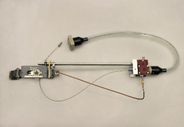EPR stopped-flow.
Stopped Flow accessories
An accessory designed to couple the stopped-flow mixer to a variety of EPR flow resonators enabling users to follow the time-dependent change in amplitude of an EPR signal in a distinct field value
EPR stopped-flow
Electron Paramagnetic Resonance (EPR) detection with freeze quench and stopped flow has been used for many years to follow kinetics.
The modular design of the BioLogic SFM series now allows easy coupling of a stopped-flow mixer with a variety of EPR flow resonators meaning that the time-dependent change in amplitude of an EPR signal in a distinct field value can now be followed.
This makes stopped-flow a useful technique for measurements of the rate constant for formation, decay or conversion of paramagnetic species.
The EPR stopped-flow accessory consists of an umbilical connector especially engineered in such a way that a Berger Ball mixer can be fitted on one end to minimize the dead volume of the set-up.
A flow resonator for fast kinetics measurements
A flow resonator is attached directly at the exit of the mixer using an adaptor ring, or optionally with an HPLC type tubing. Temperature is controlled from the driving syringe to the mixer. The dead time of the EPR stopped-flow set-up depends on the design of the flow resonator. The geometry chosen will limit the flow rate and determines the dead volume. Data showing 330 μs dead time using two dielectric rings type resonator* have been published.

Picture: EPR adapter attached to a flow resonator (picture: courtesy of Mr P.P. Schmidt , Max-Planck institute, Mulheim)
Specifications
EPR stopped-flow accessory includes: ● Umbilical connector,
● Built-in Berger Ball mixer with open exit,
● Adaptor for resonator,
● Viton® O-rings.Not included: ● EPR flow resonator Specifications Umbilical volume 200 μl Built-in mixer Berger Ball Material peek Dead time (depending onresonator geometry) 0.33 ms




